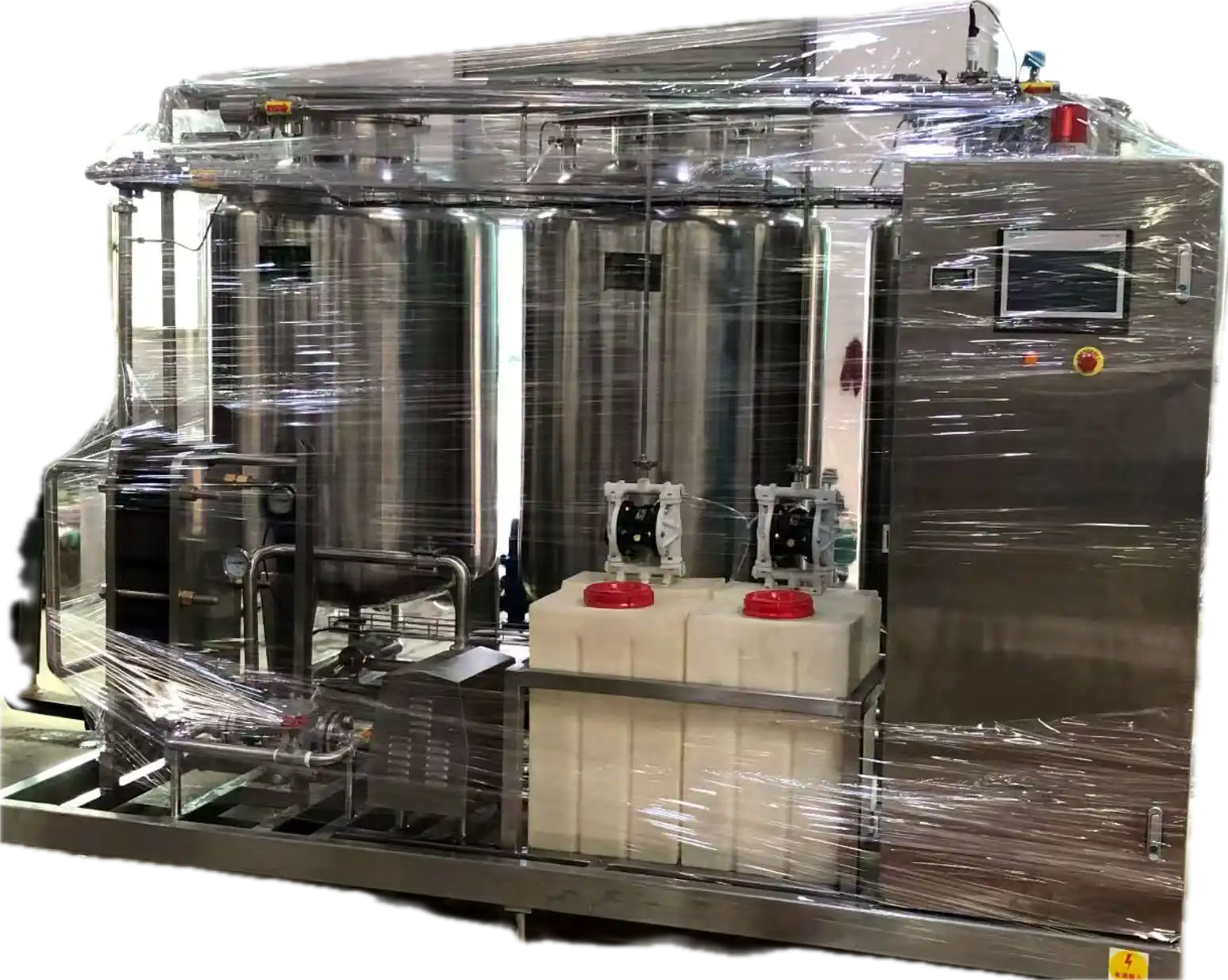การล้างระบบ CIP (Cleaning in Place) ในการผลิตอาหาร ยา เคมีภัณฑ์
ระบบสะอาด ผลิตภัณฑ์ปลอดภัย! รู้จักการล้างระบบ CIP
ที่ช่วยรักษามาตรฐานอุตสาหกรรมอาหาร ยา และเคมีภัณฑ์ได้อย่างมีประสิทธิภาพ

ในอุตสาหกรรมการผลิตอาหาร ยา และเคมีภัณฑ์ ความสะอาดของระบบการผลิตเป็นสิ่งสำคัญอย่างยิ่งต่อคุณภาพของผลิตภัณฑ์และความปลอดภัยของผู้บริโภค ระบบ CIP (Cleaning in Place) เป็นเทคโนโลยีที่ช่วยทำความสะอาดอุปกรณ์ภายในกระบวนการผลิตโดยไม่ต้องถอดชิ้นส่วน ช่วยลดระยะเวลาหยุดผลิต ลดการใช้แรงงาน และเพิ่มประสิทธิภาพในการกำจัดสิ่งปนเปื้อน
โดยการทำ CIP สามารถแบ่งออกเป็นขั้นตอนและเทคนิคต่างๆ ได้ดังนี้
- การเลือกสารทำความสะอาด
- สารเคมี: ใช้สารเคมีที่เหมาะสม เช่น โซเดียมไฮโปคลอไรต์ (Sodium hypochlorite), กรดไนตริก (Nitric acid), โซเดียมไฮดรอกไซด์ (Sodium hydroxide) หรือสารทำความสะอาดชนิดพิเศษ (เช่น สารละลายที่สามารถทำความสะอาดได้ทั้งไขมันและโปรตีน)
- อุณหภูมิ: การใช้อุณหภูมิสูงในการทำความสะอาด (เช่น 70-80 องศาเซลเซียส) จะช่วยให้การละลายคราบไขมันหรือโปรตีนทำได้ดียิ่งขึ้น
- ความเข้มข้น: การเลือกใช้ความเข้มข้นของสารทำความสะอาดจะขึ้นอยู่กับลักษณะของคราบและปริมาณที่ต้องการล้าง
- การล้างน้ำร้อนและน้ำเย็น
- การล้างน้ำร้อน: จะใช้ในการล้างเพื่อให้น้ำหรือสารเคมีสามารถละลายคราบไขมันและเศษสารเคมีได้ง่ายขึ้น การใช้ความร้อนยังช่วยลดการสะสมของเชื้อแบคทีเรีย
- การล้างน้ำเย็น: ใช้ในการล้างเพื่อล้างคราบที่ละลายจากน้ำร้อนออกจากระบบ ก่อนที่จะทำการใช้น้ำหรือสารเคมีในขั้นตอนถัดไป
- การทำความสะอาดขั้นต้น (Pre-rinse)
- เริ่มต้นโดยการล้างระบบด้วยน้ำเย็นหรืออุ่น เพื่อขจัดเศษผลิตภัณฑ์ที่หลงเหลือในระบบออก ก่อนที่จะเริ่มการใช้งานสารเคมีที่เข้มข้น
- ขั้นตอนนี้ช่วยลดปริมาณสารเคมีที่ต้องใช้ในขั้นตอนถัดไปและประหยัดค่าใช้จ่าย
- การทำความสะอาดด้วยสารเคมี (Chemical wash)
- หลังจากการล้างน้ำร้อนหรือเย็นแล้วจะต้องทำการล้างด้วยสารเคมี เช่น โซเดียมไฮดรอกไซด์ (สำหรับคราบไขมัน) หรือกรด (สำหรับคราบแร่ธาตุ) เพื่อขจัดคราบที่ฝังลึก
- ต้องใช้เวลาในการทำปฏิกิริยาและความเข้มข้นที่เหมาะสม
- ปกติแล้วจะมีการวนหรือไหลเวียนของสารทำความสะอาดในระบบเพื่อให้ครอบคลุมและทำความสะอาดได้ทั่วถึง
- การล้างด้วยน้ำบริสุทธิ์ (Rinse)
- หลังจากใช้สารเคมีในการทำความสะอาดแล้ว ต้องทำการล้างระบบด้วยน้ำสะอาดหลายๆ รอบ เพื่อล้างสารเคมีตกค้างออกจากระบบ
- การล้างน้ำต้องทำให้ระบบสะอาดจากสารเคมีทุกชนิด โดยการทดสอบระดับความเป็นกรด-ด่าง (pH) ของน้ำล้างสุดท้าย เพื่อให้มั่นใจว่าไม่มีสารเคมีตกค้าง
- การทำความสะอาดขั้นสุดท้าย (Sanitization)
- หลังจากล้างน้ำแล้ว อาจมีการใช้สารฆ่าเชื้อ (เช่น แอลกอฮอล์, คลอรีน) เพื่อฆ่าเชื้อจุลินทรีย์ที่อาจหลงเหลือในระบบ
- ขั้นตอนนี้มีความสำคัญอย่างยิ่งในอุตสาหกรรมยาและอาหาร เนื่องจากมีข้อกำหนดในการควบคุมความสะอาดอย่างเข้มงวด
- การตรวจสอบและบันทึกข้อมูล
- หลังจากการล้างระบบแล้ว จะต้องมีการตรวจสอบผลการล้างโดยการทดสอบการสะอาด เช่น การทดสอบที่มีการใช้เครื่องมือวัด pH หรือการวัดปริมาณสารตกค้าง
- บันทึกข้อมูลการล้าง เช่น เวลา, อุณหภูมิ, ความเข้มข้นของสารเคมี เพื่อใช้ในการควบคุมและตรวจสอบคุณภาพ

เทคนิคเพิ่มเติม:
- การใช้ระบบ CIP อัตโนมัติ: ระบบ CIP อัตโนมัติจะช่วยให้การล้างเป็นไปอย่างมีประสิทธิภาพและปลอดภัย โดยสามารถควบคุมการไหลเวียนของน้ำและสารเคมีตามมาตรฐานที่กำหนดได้อย่างแม่นยำ
- การควบคุมเวลาและอุณหภูมิ: การใช้เวลาและอุณหภูมิที่เหมาะสมจะทำให้การล้างเป็นไปได้ดีที่สุด เช่น การล้างด้วยอุณหภูมิสูงในระยะเวลาที่เหมาะสม
- การตรวจสอบประสิทธิภาพการล้าง: มีการตรวจสอบประสิทธิภาพการล้างโดยการตรวจสอบคราบต่างๆ หลังการล้าง เช่น การใช้ UV light หรือการทดสอบทางเคมีอื่นๆ
การทำการ CIP ที่ดีไม่เพียงแต่จะช่วยรักษาความสะอาด แต่ยังสามารถลดความเสี่ยงจากการปนเปื้อนที่อาจเกิดขึ้นในการผลิต จึงมีบทบาทสำคัญในการรับรองคุณภาพของผลิตภัณฑ์ในอุตสาหกรรมอาหาร ยา และเคมีภัณฑ์
Better Technology for Better Life สนใจขอคำปรึกษา กับวิศวกร เรโน เทค
โทร : 085-941-0072
LINE : @ranotech
FACEBOOK : https://www.facebook.com/ranotech
Email: [email protected]
CIP Cleaning Techniques in the Food, Pharmaceutical, and Chemical Industries
CIP (Cleaning in Place) is a crucial process in industries such as food, pharmaceuticals, and chemicals, where cleanliness and safety standards must be strictly maintained. This process allows for the cleaning of equipment and systems without disassembling components. The CIP cleaning process can be broken down into several stages and techniques, as outlined below:
- Choosing Cleaning Chemicals
- Cleaning Agents: The selection of appropriate cleaning chemicals, such as sodium hypochlorite, nitric acid, sodium hydroxide, or specialized detergents, is essential. These agents are designed to target specific residues such as fats, proteins, or minerals.
- Temperature: The use of elevated temperatures (e.g., 70-80°C) can help dissolve fat and protein residues, making them easier to remove.
- Concentration: The concentration of the cleaning chemicals should be chosen based on the type of residues and the volume to be cleaned.
- Hot and Cold Water Rinsing
- Hot Water Rinse: Hot water is used initially to dissolve grease and other residues, as it facilitates the removal of fatty or sticky substances. The use of heat also aids in reducing bacterial contamination.
- Cold Water Rinse: Cold water is often used after the hot rinse to remove any residual cleaning agents before proceeding with the chemical cleaning steps.
- Hot Water Rinse: Hot water is used initially to dissolve grease and other residues, as it facilitates the removal of fatty or sticky substances. The use of heat also aids in reducing bacterial contamination.
- Pre-rinse Stage
- The system is rinsed with warm or cold water to remove any remaining product residues. This step is essential to reduce the amount of cleaning agents needed in the next stages and to save costs.
- The pre-rinse ensures that large particles and solid residues are removed before the application of chemicals.
- The system is rinsed with warm or cold water to remove any remaining product residues. This step is essential to reduce the amount of cleaning agents needed in the next stages and to save costs.
- Chemical Cleaning (Chemical Wash)
- After the initial rinse, the system undergoes a chemical cleaning process, which involves the use of chemicals such as sodium hydroxide (for fat residues) or acids (for mineral build-ups).
- The chemicals should be applied at the appropriate concentration and for the right amount of time to effectively remove stubborn residues.
- Typically, a recirculating or flowing system is used to ensure the cleaning solution reaches all areas of the system.
- After the initial rinse, the system undergoes a chemical cleaning process, which involves the use of chemicals such as sodium hydroxide (for fat residues) or acids (for mineral build-ups).
- Rinsing with Purified Water (Rinse)
- After the chemical wash, it is essential to rinse the system with clean water several times to remove any remaining chemical residues.
- This step ensures that no cleaning agents remain in the system, and the final rinse water is often tested for pH levels to ensure that no chemicals are left behind.
- After the chemical wash, it is essential to rinse the system with clean water several times to remove any remaining chemical residues.
- Final Sanitization (Sanitization)
- After rinsing, a sanitizing agent such as alcohol or chlorine may be used to kill any remaining microorganisms in the system.
- This step is particularly critical in the food and pharmaceutical industries, where microbial contamination must be avoided at all costs.
- After rinsing, a sanitizing agent such as alcohol or chlorine may be used to kill any remaining microorganisms in the system.
- Inspection and Documentation
- Once the cleaning process is complete, it is essential to verify its effectiveness through testing, such as checking for residual residues using swabs or other analytical methods.
- Data should be recorded for each cleaning cycle, including time, temperature, and concentration of cleaning agents, to ensure compliance with cleaning standards and for future quality control.
Additional Techniques:
- Once the cleaning process is complete, it is essential to verify its effectiveness through testing, such as checking for residual residues using swabs or other analytical methods.
- Automated CIP Systems: Automated CIP systems improve efficiency and safety by ensuring that cleaning chemicals are applied in precise amounts and conditions. These systems can be programmed to follow standard operating procedures, which helps in maintaining consistent cleaning quality.
- Time and Temperature Control: Using the correct time and temperature ensures the optimal effectiveness of the cleaning process. For instance, higher temperatures may be used for a set amount of time to ensure fat or protein residues are fully dissolved.
- Cleaning Effectiveness Verification: After the cleaning process, tests such as UV light inspection or chemical residue analysis can be used to verify that the system has been thoroughly cleaned and sanitized.
Effective CIP cleaning not only helps maintain cleanliness but also reduces the risk of contamination in food, pharmaceutical, and chemical products. Thus, it plays a vital role in ensuring the quality and safety of products across these industries.



